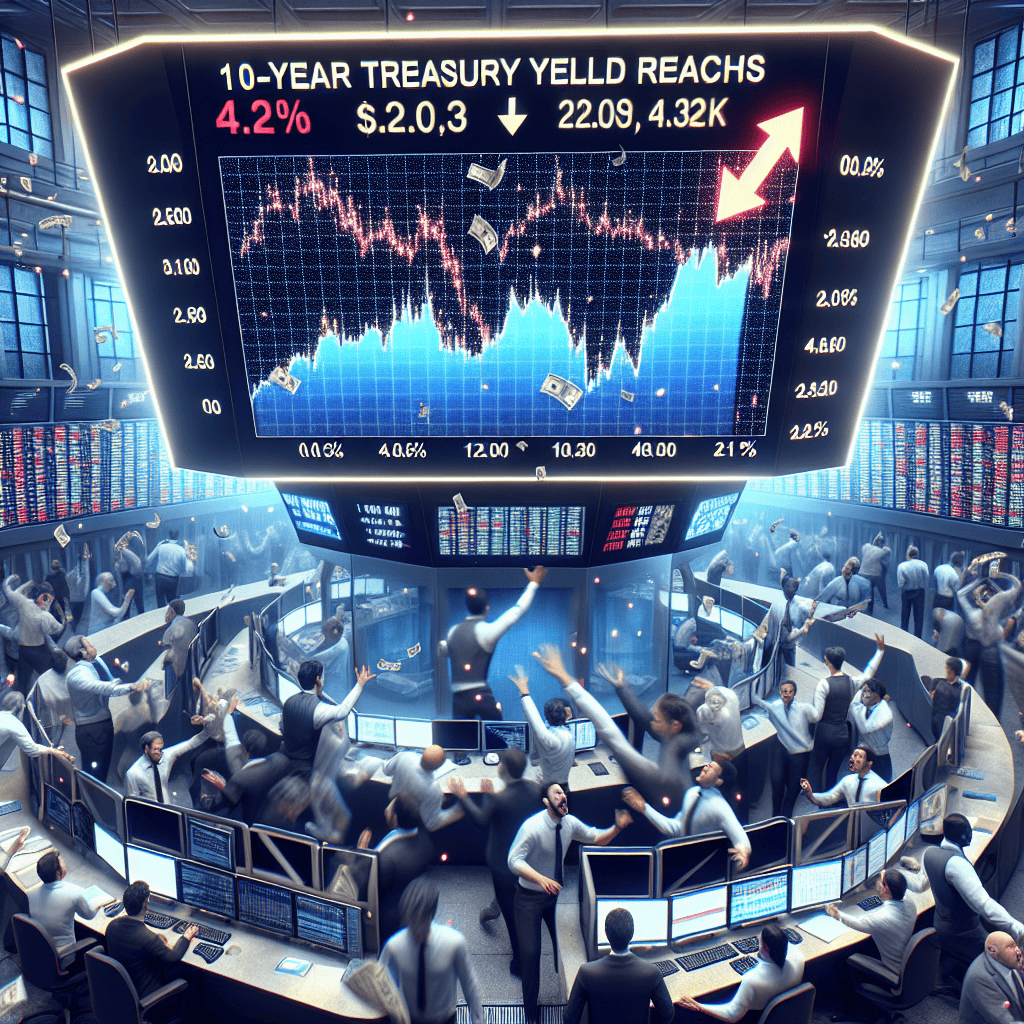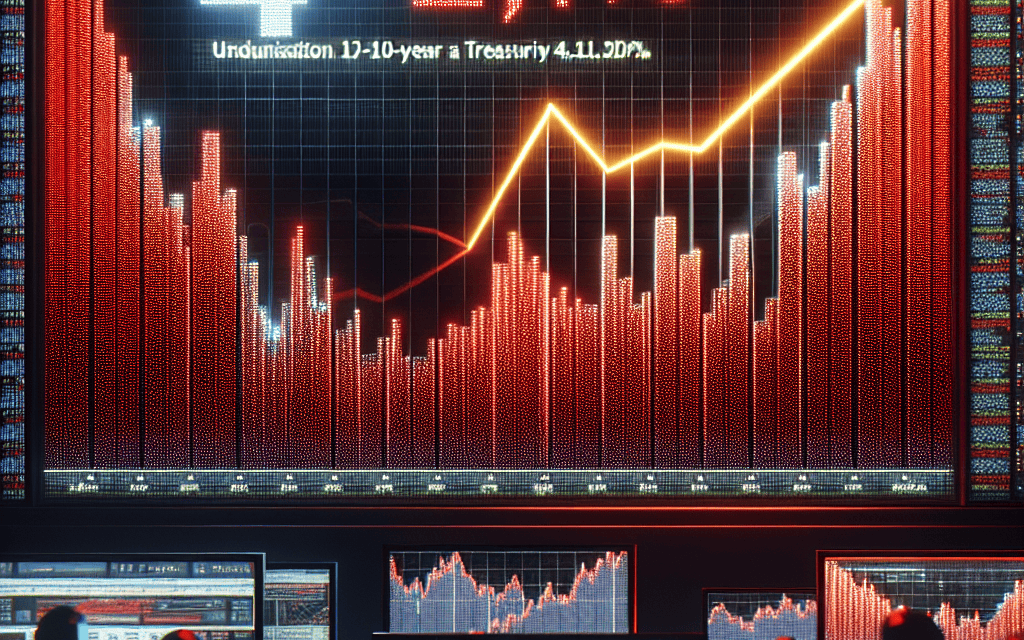“Market Jitters: 10-Year Treasury Yield Hits 4.2%, Sparking Economic Uncertainty”
Introduction
In recent financial developments, global markets have experienced significant volatility as the yield on the 10-year U.S. Treasury note surged to 4.2%. This rise in the benchmark yield, often seen as a bellwether for broader economic conditions, has sparked concerns among investors about the potential implications for borrowing costs, corporate profits, and economic growth. The increase in yields reflects a complex interplay of factors, including expectations of future interest rate hikes by the Federal Reserve, inflationary pressures, and shifts in investor sentiment. As a result, equities have faced downward pressure, with major indices reflecting heightened uncertainty and risk aversion. This development underscores the delicate balance policymakers must maintain in navigating economic recovery while managing inflationary risks.
Impact Of Rising Treasury Yields On Stock Markets
The financial markets have recently experienced significant turbulence as the 10-year Treasury yield surged to 4.2%, a level that has not been seen in years. This development has sent ripples through the stock markets, causing investors to reassess their portfolios and strategies. The rise in Treasury yields is often seen as a bellwether for the broader economy, and its impact on stock markets can be profound. As yields increase, borrowing costs for companies rise, potentially squeezing profit margins and leading to a reevaluation of stock valuations.
To understand the implications of rising Treasury yields, it is essential to consider the relationship between bond yields and stock prices. Generally, when Treasury yields rise, bond prices fall, making bonds more attractive to investors seeking stable returns. This shift can lead to a reallocation of funds from equities to bonds, exerting downward pressure on stock prices. Moreover, higher yields can signal expectations of rising inflation, prompting central banks to consider tightening monetary policy. Such actions can further dampen investor sentiment in the stock markets.
In addition to these direct effects, the increase in Treasury yields can also influence investor behavior through changes in risk perception. As yields climb, the risk-free rate of return increases, prompting investors to demand higher returns from riskier assets such as stocks. This recalibration of risk and return expectations can lead to increased volatility in the stock markets, as investors adjust their portfolios to align with the new economic landscape. Furthermore, sectors that are particularly sensitive to interest rates, such as technology and real estate, may experience more pronounced fluctuations as their valuations are reassessed.
The impact of rising Treasury yields is not uniform across all stocks or sectors. For instance, financial institutions like banks may benefit from higher yields, as they can charge more for loans, potentially boosting their profit margins. Conversely, companies with high levels of debt may face increased interest expenses, which could weigh on their earnings and stock performance. This divergence in sectoral impacts underscores the importance of a nuanced approach to investing during periods of rising yields.
While the immediate reaction to the increase in Treasury yields has been a sell-off in the stock markets, it is crucial to consider the broader economic context. Rising yields can be indicative of a strengthening economy, as investors demand higher returns in anticipation of robust growth and inflation. In this light, the current market volatility may be a temporary adjustment rather than a harbinger of a prolonged downturn. Investors with a long-term perspective may find opportunities in the current market environment, particularly in sectors poised to benefit from economic expansion.
In conclusion, the recent rise in the 10-year Treasury yield to 4.2% has had a significant impact on stock markets, prompting a reassessment of risk and return expectations. While the immediate effects have been negative for equities, the broader economic implications suggest a more complex picture. As investors navigate this challenging environment, a focus on diversification and a keen understanding of sectoral dynamics will be essential. Ultimately, the interplay between Treasury yields and stock markets underscores the intricate connections within the financial system, highlighting the need for informed decision-making in the face of uncertainty.
Historical Analysis Of Treasury Yields And Market Volatility
The recent surge in the 10-year Treasury yield to 4.2% has sent ripples through financial markets, causing significant volatility and raising concerns among investors. Historically, the relationship between Treasury yields and market performance has been intricate, often reflecting broader economic conditions and investor sentiment. To understand the current market turbulence, it is essential to examine the historical context of Treasury yields and their impact on market volatility.
Treasury yields, particularly the 10-year yield, serve as a benchmark for various financial instruments, influencing everything from mortgage rates to corporate borrowing costs. When yields rise, it often signals expectations of higher inflation and economic growth, prompting investors to reassess their portfolios. However, a rapid increase in yields can also lead to market instability, as it raises the cost of borrowing and can dampen economic activity. This dual nature of Treasury yields makes them a critical factor in market dynamics.
Looking back, periods of rising Treasury yields have frequently coincided with heightened market volatility. For instance, during the late 1970s and early 1980s, the U.S. experienced a sharp increase in yields as the Federal Reserve aggressively raised interest rates to combat inflation. This period was marked by significant market fluctuations, as investors grappled with the implications of tighter monetary policy. Similarly, in the mid-1990s, a series of rate hikes led to a spike in yields, resulting in a temporary market downturn.
Moreover, the financial crisis of 2008 provides another illustrative example. In the aftermath of the crisis, Treasury yields plummeted as investors sought safe-haven assets, leading to a prolonged period of low yields. However, as the economy began to recover, yields gradually increased, causing periodic bouts of market volatility as investors adjusted to the changing economic landscape. This pattern underscores the sensitivity of markets to shifts in Treasury yields and the broader economic environment.
In the current context, the rise in the 10-year Treasury yield to 4.2% reflects a complex interplay of factors. On one hand, it suggests optimism about economic growth and a potential return to pre-pandemic normalcy. On the other hand, it raises concerns about inflationary pressures and the possibility of more aggressive monetary tightening by the Federal Reserve. This uncertainty has contributed to the recent market turbulence, as investors weigh the potential risks and rewards of different asset classes.
Furthermore, the global nature of financial markets means that changes in U.S. Treasury yields can have far-reaching implications. As yields rise, they can attract foreign capital, leading to currency fluctuations and impacting international trade dynamics. This interconnectedness adds another layer of complexity to the current market environment, as investors must consider not only domestic factors but also global economic trends.
In conclusion, the recent increase in the 10-year Treasury yield to 4.2% has reignited concerns about market volatility, echoing historical patterns where rising yields have led to financial instability. By examining past episodes of yield fluctuations and their impact on markets, investors can gain valuable insights into the potential challenges and opportunities that lie ahead. As always, maintaining a balanced perspective and staying informed about economic developments will be crucial for navigating the evolving financial landscape.
Investor Strategies During High Treasury Yield Periods
As the financial markets react to the recent surge in the 10-year Treasury yield, which has reached a notable 4.2%, investors are faced with the challenge of navigating this high-yield environment. This development has significant implications for various asset classes, prompting a reassessment of investment strategies. Understanding the dynamics at play is crucial for investors seeking to optimize their portfolios during such periods.
To begin with, the rise in Treasury yields often signals a shift in the economic landscape. Higher yields typically reflect expectations of stronger economic growth and potential inflationary pressures. Consequently, this environment can lead to increased volatility in equity markets, as investors reassess the risk-reward profiles of their investments. In such scenarios, equities, particularly those with high valuations, may experience downward pressure as the cost of borrowing rises and future cash flows are discounted at higher rates.
In response to these conditions, investors might consider diversifying their portfolios to mitigate risk. One strategy involves increasing exposure to sectors that traditionally perform well in rising interest rate environments. For instance, financial stocks, such as banks and insurance companies, often benefit from higher yields due to improved net interest margins. Additionally, sectors like energy and materials may also offer opportunities, as they can capitalize on economic growth and inflationary trends.
Moreover, fixed-income investors face unique challenges during periods of rising Treasury yields. As bond prices inversely correlate with yields, existing bond holdings may suffer declines in value. To address this, investors might explore shorter-duration bonds, which are less sensitive to interest rate changes. Alternatively, inflation-protected securities, such as Treasury Inflation-Protected Securities (TIPS), can provide a hedge against inflation while offering a degree of safety.
Furthermore, the international landscape presents additional considerations. As U.S. Treasury yields rise, the dollar often strengthens, impacting global markets and foreign investments. Investors with international exposure should be mindful of currency risks and consider strategies to hedge against potential fluctuations. Diversifying across regions and asset classes can help mitigate these risks and provide a buffer against volatility.
In addition to these strategies, maintaining a long-term perspective is essential. While short-term market fluctuations can be unsettling, it is important to remember that rising yields are often indicative of a healthy economy. Investors should focus on their long-term goals and avoid making impulsive decisions based on short-term market movements. Regular portfolio reviews and adjustments, aligned with individual risk tolerance and investment objectives, can help ensure that portfolios remain resilient.
Finally, consulting with financial advisors can provide valuable insights and guidance during periods of market uncertainty. Advisors can offer tailored strategies that align with an investor’s unique circumstances and goals, helping to navigate the complexities of a high-yield environment.
In conclusion, the recent rise in the 10-year Treasury yield to 4.2% presents both challenges and opportunities for investors. By understanding the implications of this development and employing strategic adjustments, investors can position themselves to weather the volatility and potentially benefit from the evolving economic landscape. Through diversification, careful selection of asset classes, and a focus on long-term objectives, investors can effectively manage their portfolios during periods of high Treasury yields.
The Relationship Between Bond Yields And Equity Markets

The financial markets have recently experienced significant turbulence as the 10-year Treasury yield surged to 4.2%, a development that has sent ripples through equity markets worldwide. Understanding the intricate relationship between bond yields and equity markets is crucial for investors seeking to navigate these volatile times. As bond yields rise, they often signal shifts in economic conditions and investor sentiment, which can have profound implications for stock prices.
To begin with, the 10-year Treasury yield is a critical benchmark in the financial world, serving as a barometer for interest rates and economic expectations. When this yield increases, it typically reflects investors’ anticipation of higher inflation and stronger economic growth. However, it also means that borrowing costs for businesses and consumers are likely to rise, potentially dampening economic activity. Consequently, higher yields can lead to a reevaluation of stock valuations, as the present value of future cash flows is discounted at a higher rate, making equities less attractive relative to bonds.
Moreover, the relationship between bond yields and equity markets is further complicated by the concept of opportunity cost. As yields on government bonds rise, they offer a more attractive risk-free return compared to equities, prompting some investors to shift their portfolios from stocks to bonds. This reallocation of assets can exert downward pressure on stock prices, as demand for equities diminishes. Additionally, sectors that are particularly sensitive to interest rates, such as utilities and real estate, may experience more pronounced declines, given their reliance on debt financing and the impact of higher rates on their cost structures.
Furthermore, the recent increase in the 10-year Treasury yield has been accompanied by heightened concerns about inflationary pressures. Central banks, including the Federal Reserve, may respond to rising inflation by tightening monetary policy, which could involve raising interest rates. Such actions are generally perceived as negative for equity markets, as they increase the cost of capital and can slow economic growth. Investors, therefore, remain vigilant, closely monitoring central bank communications for any indications of policy shifts that could further influence market dynamics.
In addition to these factors, the global nature of financial markets means that changes in U.S. Treasury yields can have far-reaching effects. International investors often look to U.S. Treasuries as a safe haven, and fluctuations in yields can impact currency exchange rates and capital flows. A rising yield environment in the United States may lead to a stronger dollar, which can affect the competitiveness of U.S. exports and the earnings of multinational corporations. This interconnectedness underscores the complexity of the relationship between bond yields and equity markets, as investors must consider a multitude of variables when making investment decisions.
In conclusion, the recent surge in the 10-year Treasury yield to 4.2% has underscored the delicate balance between bond yields and equity markets. As investors grapple with the implications of higher yields, they must weigh the potential for increased borrowing costs, shifts in asset allocation, and the broader economic outlook. While the path forward remains uncertain, understanding the interplay between these financial instruments is essential for navigating the challenges and opportunities that lie ahead. As always, maintaining a diversified portfolio and staying informed about market developments will be key strategies for investors seeking to weather the current market volatility.
Economic Indicators Influencing Treasury Yields
The recent surge in the 10-year Treasury yield to 4.2% has sent ripples through financial markets, causing significant declines in stock prices and raising concerns about the broader economic implications. Understanding the factors influencing Treasury yields is crucial for investors and policymakers alike, as these yields serve as a benchmark for various interest rates across the economy. Several economic indicators play a pivotal role in shaping the trajectory of Treasury yields, and their interplay can offer insights into future market movements.
To begin with, inflation expectations are a primary driver of Treasury yields. When investors anticipate higher inflation, they demand higher yields to compensate for the eroding purchasing power of future interest payments. Recent data indicating persistent inflationary pressures, driven by supply chain disruptions and robust consumer demand, have heightened these expectations. Consequently, the Federal Reserve’s monetary policy stance becomes a critical factor. As the central bank signals its intentions to tighten monetary policy by raising interest rates or tapering asset purchases, yields tend to rise in anticipation of these actions. The Fed’s recent communications have suggested a more hawkish approach, contributing to the upward pressure on yields.
Moreover, economic growth prospects significantly influence Treasury yields. Strong economic growth typically leads to higher yields, as it suggests increased demand for capital and potential inflationary pressures. Recent economic indicators, such as employment figures and GDP growth rates, have painted a mixed picture. While the labor market has shown resilience, other sectors have faced headwinds, creating uncertainty about the sustainability of growth. This uncertainty can lead to volatility in Treasury yields as investors reassess their expectations.
In addition to domestic factors, global economic conditions also play a role in determining Treasury yields. The interconnectedness of global financial markets means that developments in major economies, such as the European Union and China, can impact U.S. yields. For instance, if economic conditions in these regions deteriorate, leading to increased demand for safe-haven assets like U.S. Treasuries, yields may be driven lower. Conversely, strong global growth can exert upward pressure on yields as capital flows shift towards riskier assets.
Furthermore, fiscal policy decisions can influence Treasury yields. Government borrowing needs, driven by budget deficits and spending programs, affect the supply of Treasuries in the market. An increase in government debt issuance can lead to higher yields if demand does not keep pace with supply. Recent discussions around fiscal policy, including infrastructure spending and social programs, have raised questions about future borrowing requirements and their impact on yields.
Lastly, investor sentiment and market dynamics cannot be overlooked. The behavior of institutional investors, such as pension funds and insurance companies, as well as foreign central banks, can significantly impact Treasury yields. Changes in risk appetite, driven by geopolitical events or shifts in market sentiment, can lead to sudden movements in yields as investors adjust their portfolios.
In conclusion, the rise in the 10-year Treasury yield to 4.2% reflects a complex interplay of economic indicators, including inflation expectations, monetary policy, economic growth prospects, global conditions, fiscal policy, and investor sentiment. As these factors continue to evolve, they will shape the future trajectory of Treasury yields and, by extension, influence broader financial markets. Understanding these dynamics is essential for navigating the current economic landscape and making informed investment decisions.
How Treasury Yields Affect Consumer Borrowing Costs
The recent surge in the 10-year Treasury yield to 4.2% has sent ripples through financial markets, causing significant declines in stock prices and raising concerns about the broader economic implications. This development is particularly noteworthy as Treasury yields play a crucial role in determining consumer borrowing costs, influencing everything from mortgage rates to credit card interest rates. Understanding the relationship between Treasury yields and consumer borrowing costs is essential for comprehending the potential impact on household finances and the broader economy.
To begin with, Treasury yields are often considered a benchmark for interest rates across the economy. When the yield on the 10-year Treasury note rises, it typically signals an increase in the cost of borrowing. This is because Treasury securities are viewed as virtually risk-free investments, and their yields serve as a baseline for other interest rates. Consequently, when Treasury yields climb, lenders often raise the interest rates they charge on loans to maintain their profit margins. This can lead to higher borrowing costs for consumers, affecting their ability to finance major purchases such as homes and cars.
Moreover, the impact of rising Treasury yields extends beyond individual loans. For instance, mortgage rates are closely tied to the yields on long-term Treasury securities. As the 10-year Treasury yield increases, mortgage lenders may raise the rates they offer to homebuyers. This can make homeownership more expensive, potentially dampening demand in the housing market. In turn, a slowdown in the housing market can have broader economic repercussions, as it affects related industries such as construction, real estate, and home improvement.
In addition to mortgages, other forms of consumer credit are also influenced by Treasury yields. Credit card interest rates, for example, are often linked to the prime rate, which is influenced by the Federal Reserve’s monetary policy and, indirectly, by Treasury yields. As yields rise, credit card companies may increase their rates, making it more costly for consumers to carry balances on their cards. This can lead to reduced consumer spending, which is a critical driver of economic growth.
Furthermore, the relationship between Treasury yields and consumer borrowing costs is not just a matter of direct influence. Rising yields can also affect consumer confidence and spending behavior. When borrowing costs increase, consumers may become more cautious about taking on new debt or making large purchases. This shift in behavior can have a dampening effect on economic activity, as consumer spending accounts for a significant portion of GDP.
In light of these considerations, the recent increase in the 10-year Treasury yield to 4.2% is a development that warrants close attention. While higher yields can reflect investor optimism about economic growth, they also pose challenges by raising borrowing costs for consumers. Policymakers and market participants will need to carefully monitor the situation to assess its potential impact on the economy and financial markets. As the dynamics between Treasury yields and consumer borrowing costs continue to evolve, understanding these relationships will be crucial for navigating the complexities of the current economic landscape.
Global Market Reactions To U.S. Treasury Yield Changes
The recent surge in the 10-year U.S. Treasury yield to 4.2% has sent ripples through global financial markets, prompting a wave of reactions from investors and policymakers alike. This development, while not entirely unexpected, has nonetheless triggered a reassessment of risk and return across various asset classes. As the yield on these government bonds rises, it reflects investors’ expectations of future economic conditions, including inflation and interest rate trajectories. Consequently, the increase in yields has led to a significant reallocation of capital, with investors seeking to adjust their portfolios in response to the changing landscape.
In the equity markets, the impact has been pronounced. Higher yields on government bonds often lead to increased borrowing costs for companies, which can dampen corporate profits and, by extension, stock prices. As a result, major stock indices have experienced notable declines, with sectors such as technology and consumer discretionary bearing the brunt of the sell-off. These sectors, which are typically more sensitive to interest rate changes due to their reliance on future growth prospects, have seen investors retreat to safer havens. Moreover, the allure of higher yields on relatively risk-free government bonds has made equities less attractive, further exacerbating the downward pressure on stock prices.
Transitioning to the bond markets, the rise in the 10-year Treasury yield has had a dual effect. On one hand, it has led to a decline in the prices of existing bonds, as newer issues offer more attractive yields. This inverse relationship between bond prices and yields is a fundamental principle of fixed-income investing. On the other hand, the higher yields have attracted investors seeking stable returns, particularly in an environment where inflationary pressures remain a concern. This shift in investor sentiment underscores the delicate balance between risk and reward that characterizes the bond market.
In the currency markets, the implications of rising U.S. Treasury yields have been equally significant. A higher yield on U.S. government bonds tends to attract foreign capital, as investors seek to capitalize on the relatively higher returns. This influx of capital can lead to an appreciation of the U.S. dollar, as demand for the currency increases. However, a stronger dollar can pose challenges for emerging markets, which often have debt denominated in U.S. dollars. As the dollar strengthens, the cost of servicing this debt rises, potentially leading to financial strain in these economies.
Furthermore, the global economic landscape is not immune to the effects of changing U.S. Treasury yields. Central banks around the world closely monitor these developments, as they can influence domestic monetary policy decisions. For instance, a sustained rise in U.S. yields may prompt other central banks to adjust their own interest rates to maintain competitive capital flows and manage inflationary pressures. This interconnectedness highlights the far-reaching impact of U.S. Treasury yield movements on the global economy.
In conclusion, the ascent of the 10-year U.S. Treasury yield to 4.2% has set off a chain reaction across global markets, affecting equities, bonds, currencies, and economic policies. As investors navigate this evolving environment, they must weigh the implications of higher yields against the backdrop of broader economic conditions. The interplay between these factors will continue to shape market dynamics, underscoring the importance of vigilance and adaptability in investment strategies.
Q&A
1. **What caused the markets to tumble?**
The markets tumbled due to the 10-year Treasury yield reaching 4.2%.
2. **Why is the 10-year Treasury yield significant?**
The 10-year Treasury yield is significant because it serves as a benchmark for various interest rates, influencing borrowing costs and investment decisions.
3. **How does a rise in Treasury yields affect the stock market?**
A rise in Treasury yields can lead to higher borrowing costs for companies, reduce the present value of future earnings, and make bonds more attractive compared to stocks, potentially leading to a stock market decline.
4. **What sectors are most impacted by rising Treasury yields?**
Interest-sensitive sectors such as real estate, utilities, and technology are often most impacted by rising Treasury yields.
5. **How do investors typically react to rising Treasury yields?**
Investors may shift their portfolios towards bonds for safer returns, reduce exposure to high-growth stocks, and reassess riskier investments.
6. **What are the potential long-term effects of sustained high Treasury yields?**
Sustained high Treasury yields can lead to slower economic growth, increased borrowing costs, and potential challenges for government debt management.
7. **What measures can the Federal Reserve take in response to rising Treasury yields?**
The Federal Reserve can adjust monetary policy, such as altering interest rates or engaging in bond-buying programs, to influence yield levels and stabilize markets.
Conclusion
The rise in the 10-year Treasury yield to 4.2% has led to a significant downturn in the markets, reflecting investor concerns over higher borrowing costs and potential impacts on economic growth. As yields increase, the attractiveness of equities diminishes, prompting a shift towards safer, fixed-income investments. This movement suggests heightened uncertainty and caution among investors, potentially signaling a reevaluation of risk and return expectations in the current economic climate. The market’s reaction underscores the sensitivity of financial markets to interest rate fluctuations and the broader implications for investment strategies and economic stability.





